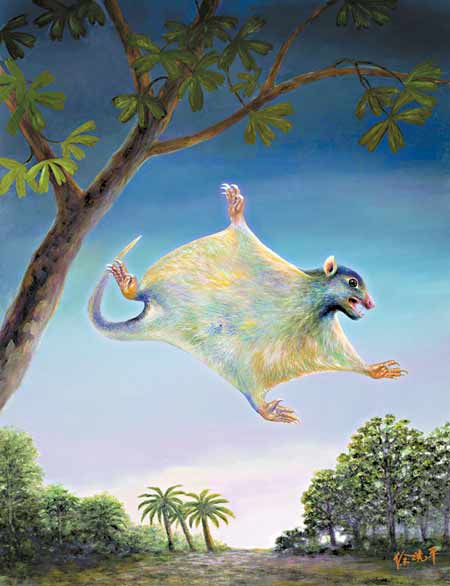| Tools: Save | Print | E-mail | Most Read |
| Prehistoric 'Flying Squirrel' from the Mongolian Steppes |
| Adjust font size: |
In "The Age of Dinosaurs," birds and pterosaurs (winged reptiles) did not rule the sky alone as previously thought. The Mesozoic airspace was also occupied by a "flying squirrel" that could glide down from treetops like a bat. Chinese scientists have uncovered the fossilized remains of a small, squirrel-sized mammal that lived at least 125 million years ago during the Mesozoic era (248 million to 65 million years ago), at a time when dinosaurs were the dominant creatures on earth. Unlike known Mesozoic mammals, the fossil had a sizable furry patagium similar to a bird's feathers, providing direct evidence of gliding flight that is rare in fossil records. This finding extends the earliest record of mammalian gliding flight to at least 70 million years ago. The previous one was by a fossil bat dating back about 51 million years and uncovered in North America. "So far it is the only known mammal that could be seen in the sky during 'The Age of the Dinosaurs'," said Wang Yuanqing, a researcher at the Chinese Academy of Sciences' Institute of Vertebrate Paleontology and Paleoanthropology. "It changes our thinking about life during the Mesozoic era." Along with Meng Jin at the American Museum of Natural History's Paleontology Department, Hu Yaoming, Wang Yuanqing, Wang Xiaolin and Li Chuankui from the institute published their findings in the most recent issue of Nature, the prestigious British science journal. The incredibly well-preserved fossil, named Volaticotherium antiquus (meaning "ancient flying beast" in Latin), was found in the dinosaur fossil beds of Inner Mongolia's Ningcheng County, already home to many rich discoveries. According to the article, the discovery demonstrates that early mammals were diverse in their means of movement and lifestyles. Mammals had experimented with gliding around the same time, if not earlier, as when birds were taking to the sky. With a length of 12-14 centimeters and an estimated weight of about 70 grams similar to that of the modern flying squirrel, the creature had a furry patagium supported by four elongated limbs and a long tail. Its unique limb and teeth structure demonstrate that it was a tree dweller that could forage on trees similar to some existent gliding mammals. "Its structure shows that it could gain altitude by climbing to a launch pad for a glide," Wang said. Like bats, it was an insect-eating animal "but it could not catch insects in flight like bats," Wang added.
(China Daily December 14, 2006) |
| Tools: Save | Print | E-mail | Most Read |
 |
| Related Stories |
|
